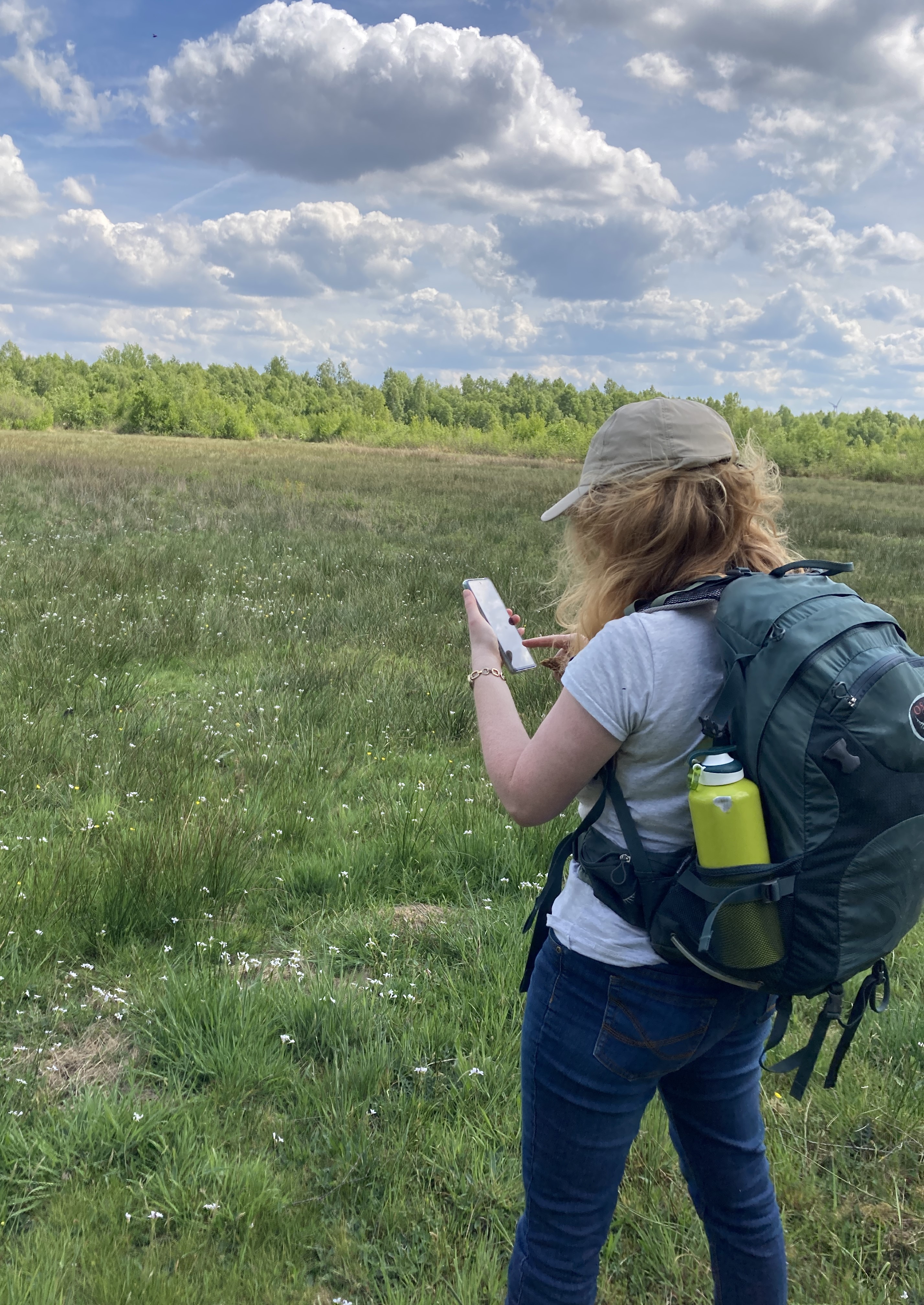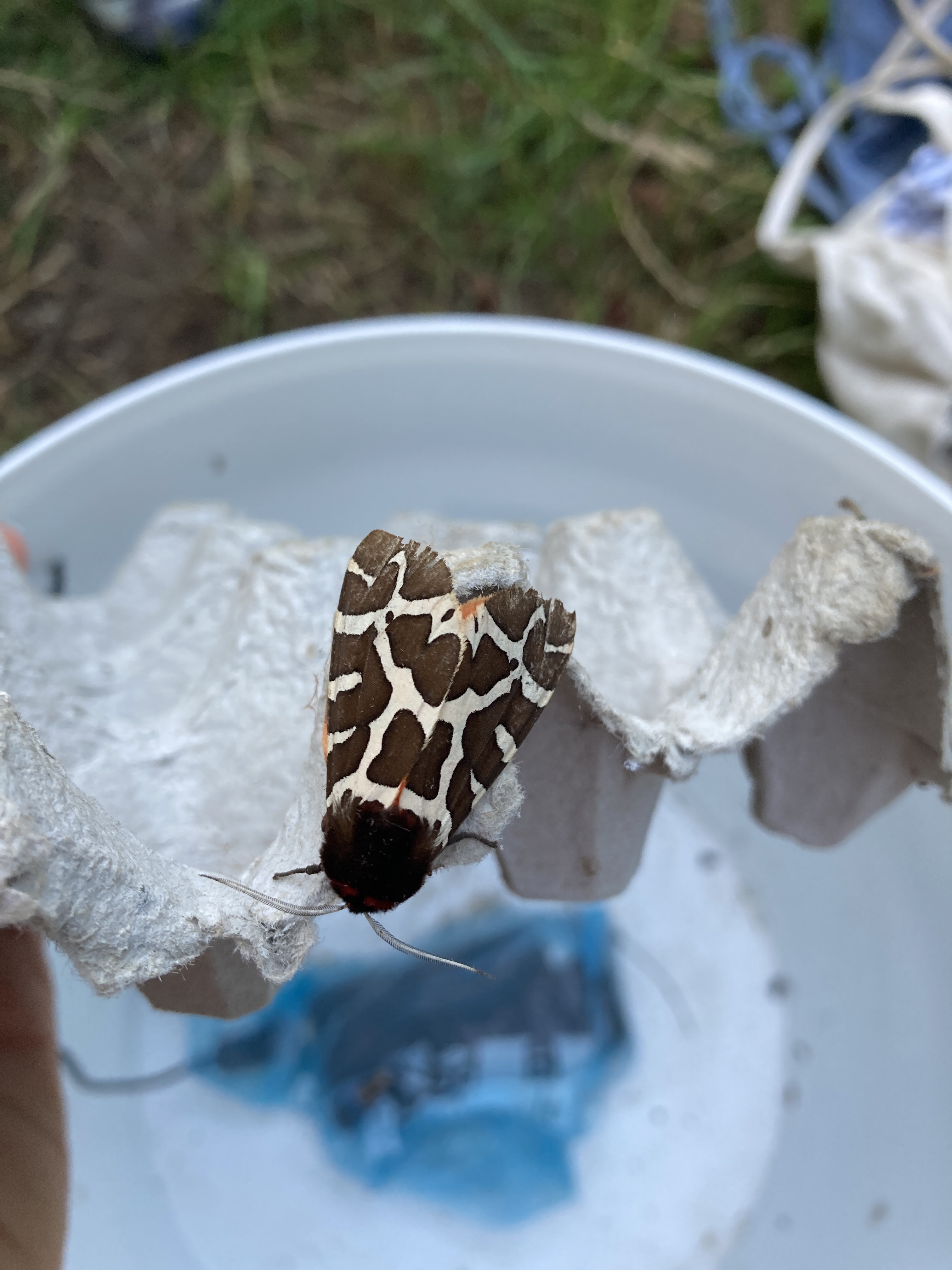Hier finden Sie Informationen zu den im eBMS enthaltenen Monitoringmethoden:
Transekt-Zählungen
15-Minuten-Zählungen
Nachtfalterfallen
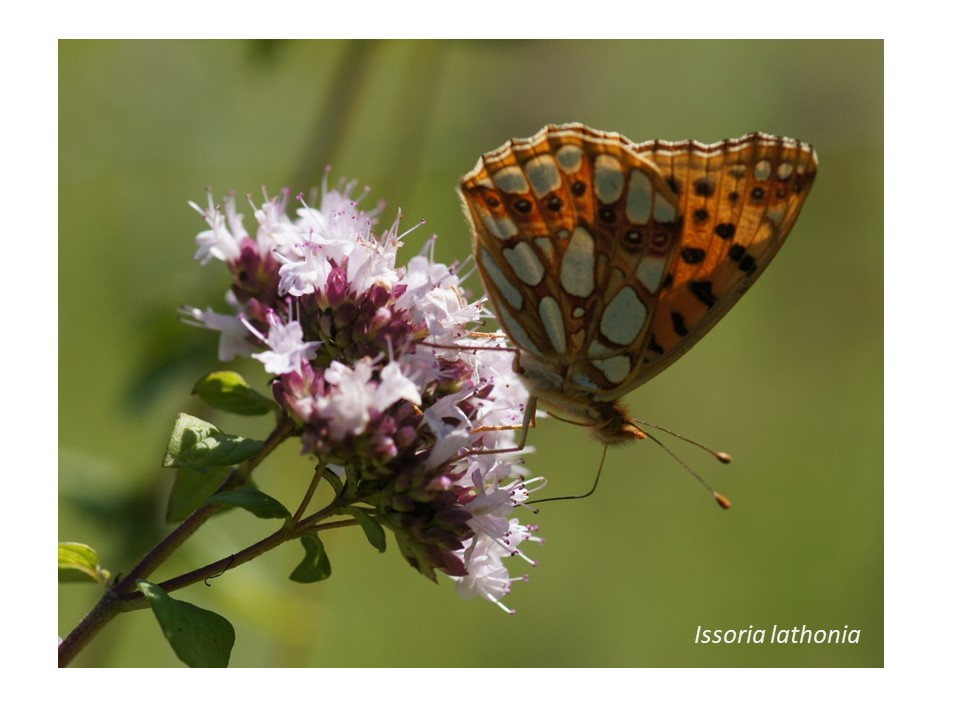
Schmetterlinge sind, wie auch einige andere Insektengruppen, in den letzten Jahrzehnten vielerorts zurückgegangen. Um die Ursachen des Rückgangs zu verstehen und effektive Schutzmaßnahmen zu entwickeln benötigt man eine bessere Datengrundlage. Citizen Science gestütztes Schmetterlingsmonitoring leistet dazu einen wichtigen Beitrag. Dank zahlreicher Freiwilligen wird der Zustand der Schmetterlingspopulationen in Europa erforscht!
Wählen Sie beim Schmetterlingsmonitoring jene Methode aus die Ihren Bedürfnissen entspricht. Schmetterlinge können von jedem beobachtet werden, der sich die Zeit nimmt und bereit ist, die Schmetterlingsarten seines Standorts kennenzulernen. Es gibt viele verschiedene Methoden, um Schmetterlinge zu zählen, doch nicht alle liefern dieselbe Qualität an Informationen.
Je nach Zielsetzung der Erhebung kann man verschiedene Methoden zur Zählung von Schmetterlingen anwenden, z.B.: Zählung von Eiern oder Gespinsten, Malaise-Fallen, Lichtfallen (Nachtfalter), Zeitzählungen (15-Minuten-Zählung) oder Transekte. Hier werden die beiden Methoden für Tagfalter erklärt, die wir im eBMS verwenden:
Habe Freude beim Schmetterlingszählen, entdecke die Natur vor der Haustüre und werde Teil einer Gemeinschaft von Freiwilligen!
Monitoring data in eBMS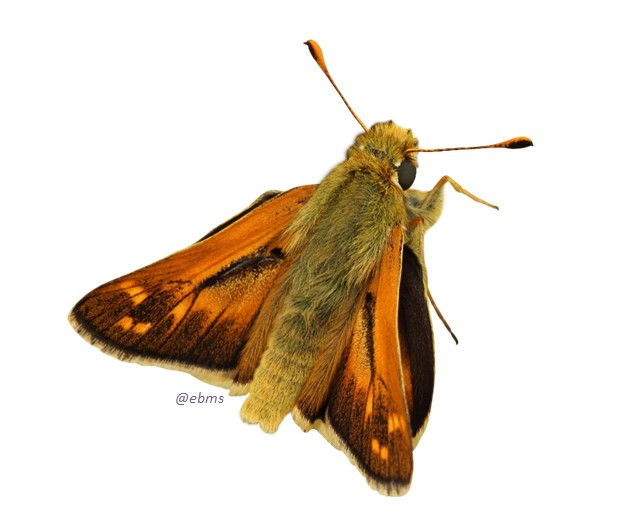
In eBMS, all the data collected involved a monitoring effort that provides incredible information for the science (species abundance). Monitored data is important and necessary to know the population trends of our species: if we want to know if one specific species is growing or decreasing in numbers, we need to use this type of methodology.
- You would need to identify the butterfly species name
- Commit to nature and nature conservation
- Invest a bit more time than with opportunistic data (just a bit more!)
The basic and more important methodology of eBMS is the transect counts where we get the most robust information on the butterfly population. All the Butterfly Monitoring Schemes are made by many different transects in their country. However, due to the difficulty of applying transects in some countries and remote areas, a new methodology 15-min Counts was created to reinforce the monitored data and give more flexibility in its collection. With 15-min Counts is expected to increase the butterfly monitored data in Europe, but a BMS should always have as a basis an important number of transects.
-> Transect Counts - Pollard Walks
A transect is a fixed route (walk) established at a site where butterflies are recorded, ideally weekly, over a number of years following some basic rules. The majority of transects are chosen by the walker and they decide which route to choose. Some schemes provide advice about areas to record to get even coverage of land cover/ habitat types as well as ensuring that a good range of the species present in a country is sufficiently monitored.
You can do the counts as part of a team: it is more fun to share experiences of what you saw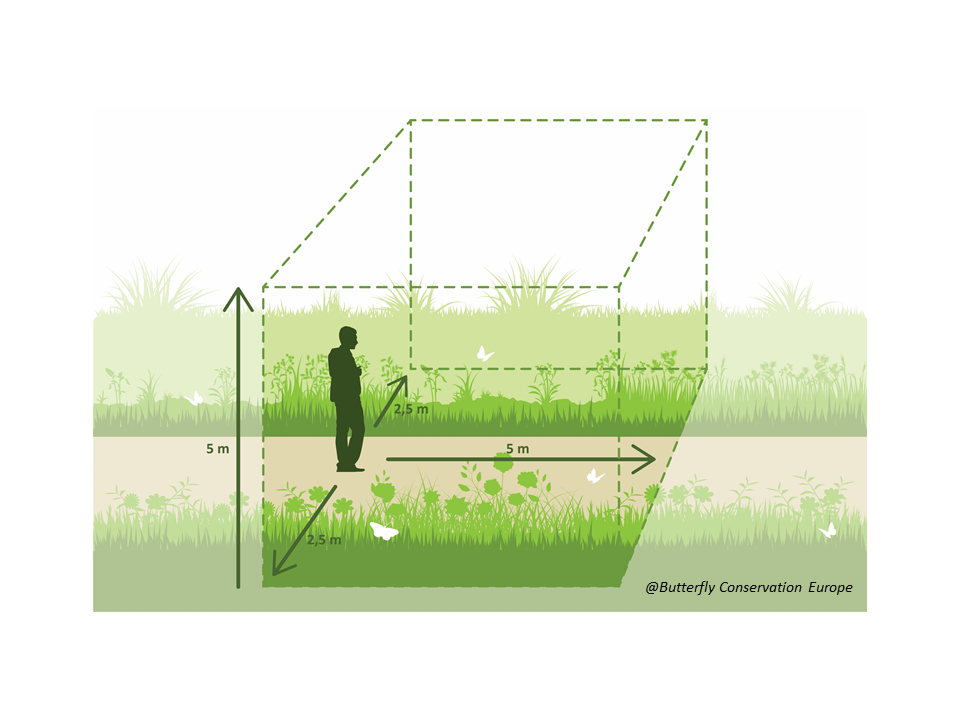 and you can replace each other during holidays. There are just a few rules to follow for doing a transect:
and you can replace each other during holidays. There are just a few rules to follow for doing a transect:
- Length? Transects are typically about 1km long and divided into sections that correspond to different habitat areas, or are a fixed length (e.g. 50m).
- When to count? Butterflies are counted when adults are present - e.g. during the flight period of butterflies. Depending on the country and the region, the flight period of butterflies will be longer or shorter (normally during spring and summer).
- Frequency? At least 10 visits per year. The transect is ideally walked every week during the butterfly flight season. If it is not possible, count as often as possible, every two weeks or 10 days. Don't leave more than 3 weeks between one visit and another. If not possible to follow this regime, your visits can be concentrated in a few months (only in spring/summer) to cover the flight period of some species.
- How to count? Count all butterfly adults present in an imaginary box of 2.5m to each side, 5m high and 5m ahead (see the image) while walking a constant pace.
- Which weather? The visits should be done with good weather: sunny and warm, with no rain and not too windy. Count when butterflies are more active, in the central hours of the day, at least with 13°C if it is sunny or 17°C with cloudiness. See the manual for more explanation regarding the weather.
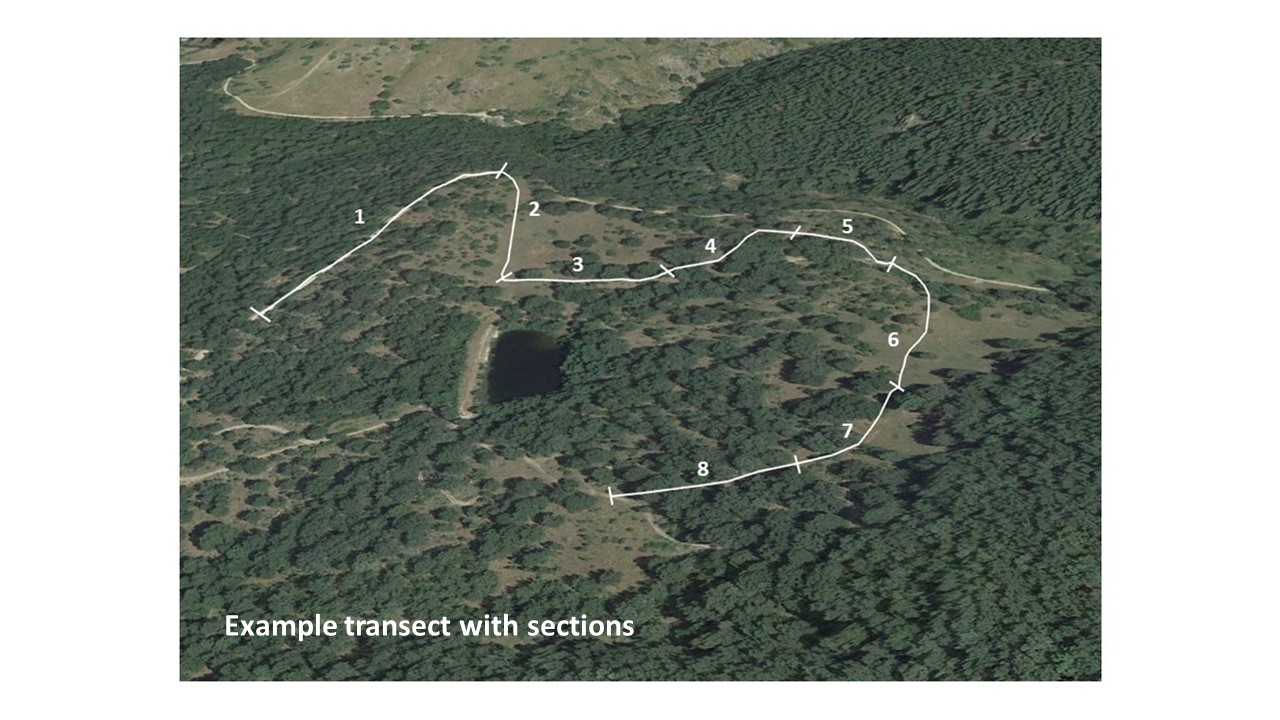
Download the Butterfly Transect Counts Manual for more explanations, it is available in several languages: Portuguese, Polish (a Manual adaptation for Poland), Spanish, Italian and Bulgarian
For registering your transect visit:
- You can download and print a Field Sheet pdf to bring it to the field
- Or you can register directly your transect visit with your phone by downloading "ButterflyCount", the eBMS app on your phone (go to the page eBMS- mobile application)
Have fun counting butterflies while helping to protect them!
-> 15-min Count
15 min counts are fun! You can count butterflies everywhere and almost any time, not only on your fixed transects but also on holiday at places you will visit just once in your life. So do it for fun!
This method consists of counting butterflies in a specific area for a fixed amount of time, in eBMS we use 15 minutes. This more flexible methodology is used to obtain butterfly abundances and it can be used to get more information of rare species, butterflies with specific behaviors, or butterfly communities of remote places but it can be used anywhere, so also in agricultural landscapes, city parks, or gardens. We recommend this type of method for people with some knowledge of butterflies who like to visit different areas and habitats. A 15-minute count is a simple method that allows recording in many places:
- on a path, route
- in a given area: a meadow, park, a garden
- at a fixed point: sitting on a balcony or terrace
The method is simple, during 15 minutes you record all the butterfly species and individuals seen. The rules to follow are similar to the ones for transects: record butterflies inside of the imaginary box (5x5x5m), with good weather, sunny and warm, with no rain and not too windy. Visiting the same area several times with a certain frequency will provide us with better data, so try to do repeated visits to the same places.
This methodology is really useful for eBMS and Butterfly Monitoring Schemes, filling gaps in areas for some countries where transects have not been set up. Keeping the same time in areas with similar extensions will produce standardised results which help us to obtain butterfly abundances. A complete list of the butterflies seen during 15-min Counts will give absence information (non-detection) that is highly valuable for statistical analysis.
A combination of transects and 15-min counts recorded in high frequency will help us in approaching the current situation of butterfly populations and produce better conservation measures and policies. 'Traditional' transect monitoring provides information on trends in time, while 15-min Counts gives extra information on densities on a spatial scale.
** Note: please be aware of doing 15-min counts in highly diverse areas for the high probability of misidentifying species. You can always support your counts by taking pictures for better identification.
How to do 15-min Counts?
Learn it fast with a explicative video
You can use the ButterflyCount app specially developed to perform this methodology of 15-min counts. The app records your track while counting butterflies for 15 minutes, if you activate your phone GPS. You will see the time running down with the possibility of pausing while taking pictures or identifying a species. When the time is over the app will let you know by vibrating.
Every species included on the list has the option to set the number of individuals seen, add pictures, life stage information, and comments. Every time you enter a new species or add new individuals, the app will save the coordinates of every individual, allowing us more detailed information on the records.
- There is an option on the ButterflyCount app to do 15-min Single Species count, for registering just one species. Designed to be used for protected or threatened species.
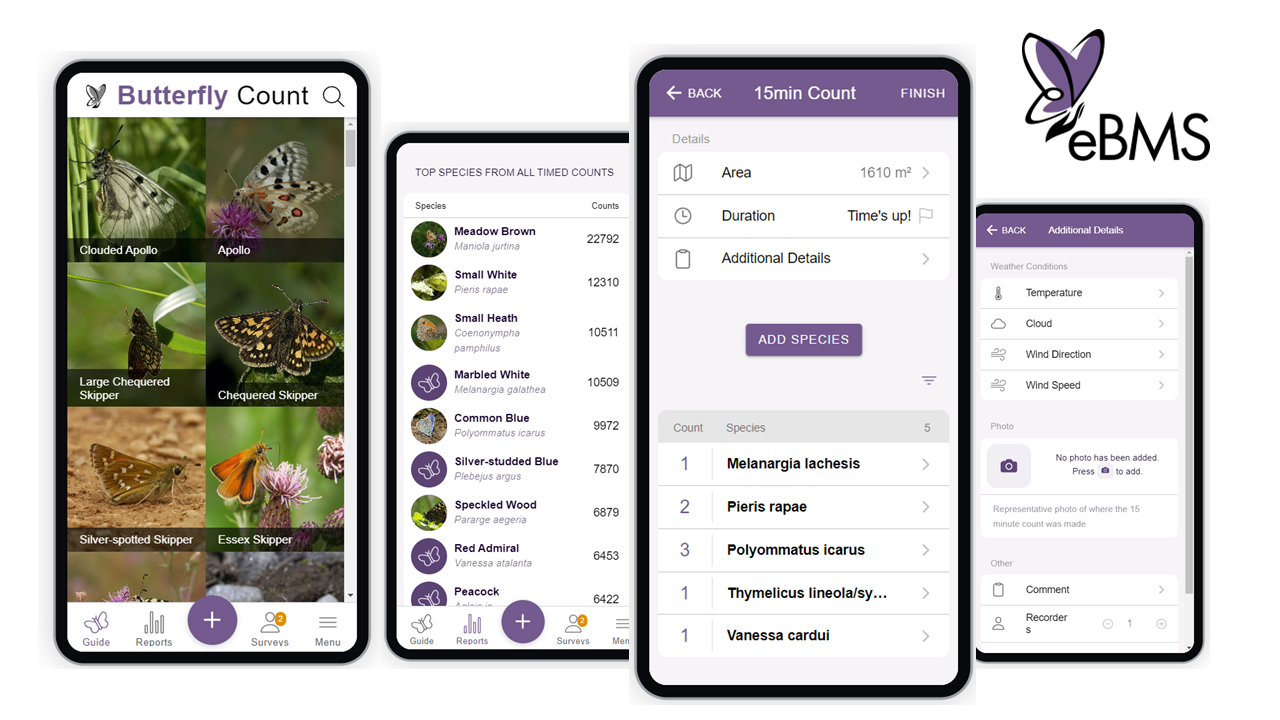 All the data submitted with 15-min counts can be downloaded via your account on the project website (www.butterfly-monitoring.net), you just need to go to the page My 15-min counts and you will find the routes, samples, and records.
All the data submitted with 15-min counts can be downloaded via your account on the project website (www.butterfly-monitoring.net), you just need to go to the page My 15-min counts and you will find the routes, samples, and records.
Discover more information on how to use the ButterflyCount app on:
- eBMS data -> eBMS - mobile application
- Playlist of ButterflyCount videos in the YouTube channel of BCE
-> Moth LED trap
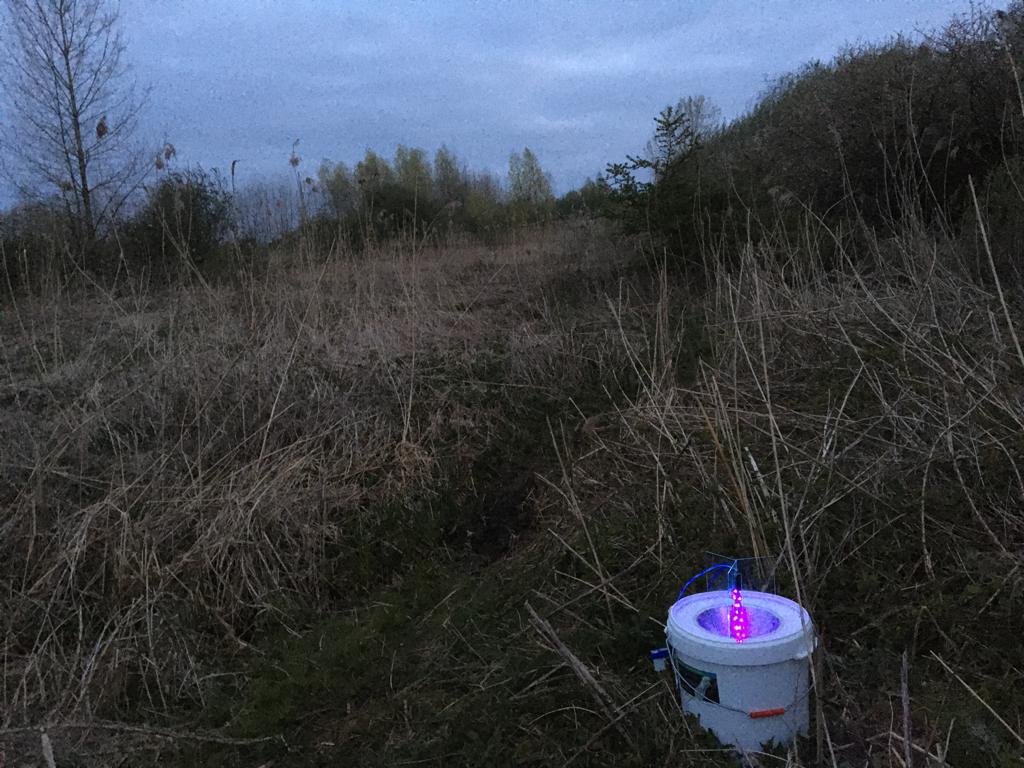 The Vlinderstichting (Dutch Butterfly Conservation, NL) designed a moth LED trap to standardise moth monitoring in Europe. The use of those traps started in the Netherlands with farmers (BIMAG project) and now it has been extending its use with the SPRING project (Pollinator Monitoring Scheme in Europe). Those traps are a simple way of monitoring moths everywhere because an electricity power connection is not needed (a power bank is enough) compared to the conventional light traps. Of course, if you want to place this LEDtrap in a nature reserve or on agricultural fields, first ask permission from the landowner.
The Vlinderstichting (Dutch Butterfly Conservation, NL) designed a moth LED trap to standardise moth monitoring in Europe. The use of those traps started in the Netherlands with farmers (BIMAG project) and now it has been extending its use with the SPRING project (Pollinator Monitoring Scheme in Europe). Those traps are a simple way of monitoring moths everywhere because an electricity power connection is not needed (a power bank is enough) compared to the conventional light traps. Of course, if you want to place this LEDtrap in a nature reserve or on agricultural fields, first ask permission from the landowner.
Moth LED trap instructions:
- Manual how to build the LEDtrap NL (pdf in English)
- Manual to set up the LEDtrap on the field: English pdf, Spanish pdf, Italian pdf, German pdf, Swedish pdf, Dutch pdf
- Manual to register moth trap samples on eBMS website: English pdf
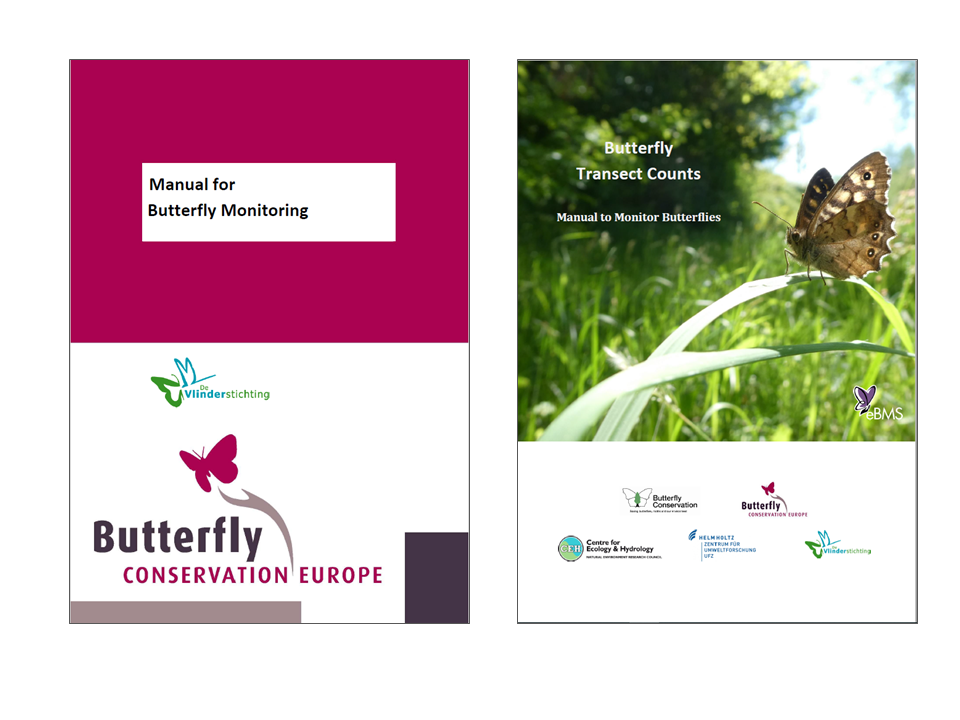
More information
If you want to have more information on these methodologies, please refer to the Manual for Butterfly Monitoring and the Butterfly Transect Counts Manual. There may be other methods used for butterfly monitoring. For studies on specific species or populations, it may be necessary to adopt more complex methods. Please refer to the list of references below to find more information about other techniques used for butterfly monitoring.
References:
Dennis, E.B.; Morgan, B.J.T.; Brereton, T.M.; Roy, D.B. & Fox, R. (2017): Using citizen science butterfly counts to predict species population trends. Conservation Biology 31 (6), 1350-1361
Nowicki, P., Settele, J., Henry, P. Y., & Woyciechowski, M. (2008). Butterfly monitoring methods: the ideal and the real world. Israel Journal of Ecology and Evolution, 54(1), 69-88.
Van Swaay, C., Regan, E., Ling, M., Bozhinovska, E., Fernandez, M., Marini-Filho, O.J., Huertas, B., Phon, C.-K., K”orösi, A., Meerman, J., Pe’er, G., Uehara-Prado, M., Sáfián, S., Sam, L., Shuey, J., Taron, D., Terblanche, R., and Underhill, L. (2015). Guidelines for Standardised Global Butterfly Monitoring. Group on Earth Observations Biodiversity Observation Network, Leipzig, Germany.
GEO BON Technical Series 1, 32pp.
Van Swaay, C.A.M., Brereton, T., Kirkland, P. and Warren, M.S. (2012) Manual for Butterfly Monitoring. Report VS2012.010, De Vlinderstichting/Dutch Butterfly Conservation, Butterfly Conservation UK & Butterfly Conservation Europe, Wageningen.
van Swaay, C. A., Nowicki, P., Settele, J., & van Strien, A. J. (2008). Butterfly monitoring in Europe: methods, applications and perspectives. Biodiversity and Conservation, 17(14), 3455-3469.

